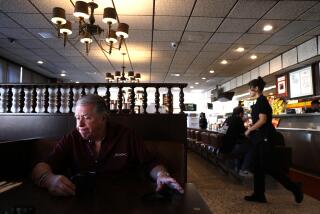AMERICAN ALBUM : Hard choice in Chicago: progress or tradition? : Maxwell Street Market, used for decades by itinerant peddlers, is facing demolition.
CHICAGO â Before dawn each Sunday, a stretch of dreary streets just west of the Dan Ryan Expressway and south of downtown becomes an American Casbah, invaded by an army of peddlers.
Sidewalks disappear beneath old blankets, card tables and steamer trunks. A dizzying array of goods is laid out: Used tools--greasy band saws, dulled ball peen hammers, twisted screwdrivers--pile up on one table; avocados, melons and dried chilies on the next, then an assemblage of secondhand toys, dirty glass tumblers, battered hats and broken kitchen devices culled from garbage dumps.
For more than 100 years, this eight-block area has made its regular weekend metamorphosis into the Maxwell Street Market, a labyrinth of entrepreneurial anarchy that pulses for a few hours, then stills.
Within the deprived landscape of urban America, in areas that long ago lost their bustling commercial strips, Maxwell Street survives--one of the nationâs few open-air markets and the only one that exists without city funding or management.
But like so many vanished inner-city hubs, Maxwell Street too is on the verge of extinction, threatened by a planned expansion of the University of Illinois at Chicago. In recent months, the university has demolished and fenced off many old shops that once lined the marketâs streets, forcing the peddlers to crowd into the streets.
âHey, weâre like ants; we can always find room,â said Frank Garcia, a 68-year-old retired city garage mechanic who has sold used goods at Maxwell Street for 37 years. On a recent Sunday, Garcia fitted himself in tightly behind a wooden table spilling over with bags of old goods. Despite the lack of room, he had what he needed most--customers picking over his wares.
Garcia and hundreds of other vendors might not have had any place to sell had it not been for a last-minute effort late this month by sociologists, planners and supporters of the market to put on a hastily arranged âcolloquiumâ to debate Maxwell Streetâs future.
The academic nature of the event--and the hope that it might produce ideas for saving the market without hindering the expansion effort--persuaded UIC officials to delay completion of their wrecking work.
âWhat we do with Maxwell Street raises questions not only of how cities deal with the needs of poor communities in the face of development pressures but how they acknowledge the history of their immigrants and working class,â says Elliot Zashin, director of the Hillel Foundation, a Jewish organization on the universityâs campus.
Zashin put together the discussions on the marketâs future in an attempt to save Maxwell Street in some form as a memorial to the Jewish shopkeepers who once populated the area. They are gone now, replaced by black, Latino and Asian vendors--but Zashin and other market supporters insist that the best way to remember their contribution is to keep Maxwell Street alive.
âHere, you see merchants starting with almost no capital, yet theyâre doing what Americans have done for decades,â Zashin said. âThey may be African-Americans now, or new immigrants, but they embody the same attempt at participation that Jewish businessmen did 30 and 40 years ago.â
The colloquium produced several ideas to save the market. Under one, the market would be moved several blocks away, far enough not to impede the universityâs progress, but close enough to continue attracting its regular clientele. Another would upgrade the market and make it a âliving museumâ by linking it to an archive reflecting Maxwell Streetâs past.
University officials have yet to express interest in any of the proposals and are still intent on using the land to build intercollegiate athletic fields, according to Ann Lodl, a UIC official.
City planner Greg Longhini said department officials are pessimistic about the marketâs survival. Even to modernize the stalls and enforce a uniform level of quality for the goods sold, Longhini said, would require several million dollars--funds the city is not willing to pay.
Most of the marketâs vendors depend on it to eke out a living. Some are homeless scavengers who comb back alleys and sell their wares for pennies. Many, like Frank Garcia, are retirees trying to supplement pensions and Social Security. On a good day, he clears $75. But even the bad days, he says, are worth it.
âI have regular customers, we sit and talk, they tell me their problems, I tell them mine.â
Elizabeth Spann, 53, a black housewife from the South Side, says the market should be saved for a more altruistic reason: âThis city is so segregated, and yet people of all races can come here and get along.â
The peddlers to her right, selling bags of peanuts, were from Guatemala. A Korean family took the stall to her left, offering a variety of produce.
âThey should keep this place alive,â Spann said, âbecause itâs history. People have been coming here for three and four generations. Itâs a lifelong habit. Itâs in peoplesâ blood. How can you close down history?â
More to Read
Sign up for Essential California
The most important California stories and recommendations in your inbox every morning.
You may occasionally receive promotional content from the Los Angeles Times.










